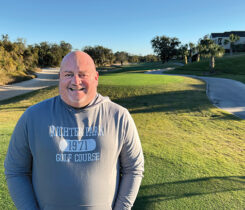What are the trends with annual bluegrass weevil in eastern North America?
The profitability of golf course operations can be significantly affected by various pests. In Eastern North America, one of the most threatening pests is the annual bluegrass weevil (ABW), Listronotus maculicollis (Kirby) (13). ABW is thought to be native to North America, where it is broadly distributed and collected from various wetland habitats such as marshes and lake margins (9).
Presently, chemical control is the only effective strategy for ABW management (14). Turfgrass managers often use broad-spectrum insecticides — primarily pyrethroids — to prevent adults from ovipositing. Not surprisingly, pyrethroid resistance has been reported (10) and seems to be on the rise. Most of the presently available insecticides seem to be less effective against resistant ABW populations (4). Insecticide resistance is a rising issue and a driving force in the rethinking of ABW management. Efforts continue to develop more sustainable management practices and improve ABW monitoring (5,6). But with the continued high expectations on turf quality, synthetic insecticides will remain an essential part of ABW management. Careful measures are needed to prevent resistance development in new populations and new chemistries.
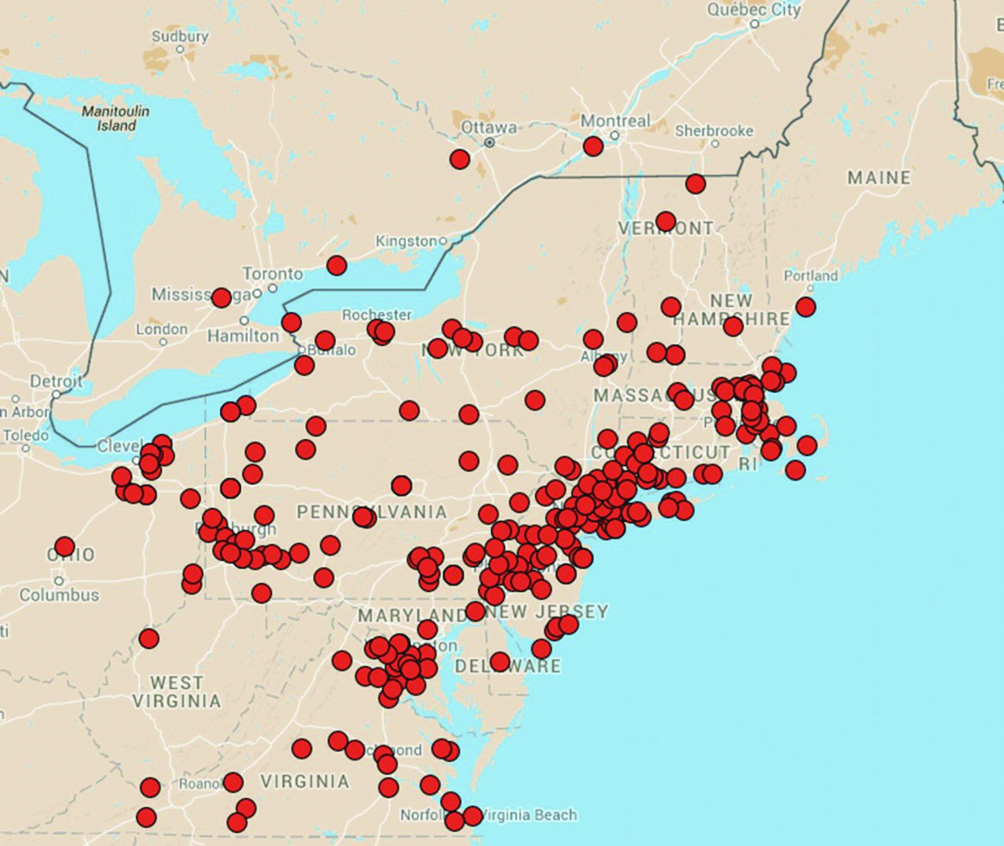
Figure 1
Our ultimate goal is to develop optimal management recommendations for the ABW population with different insecticide resistance levels. We are conducting laboratory and field studies to understand better the scope of resistance in ABW. It is also important to gather information from the superintendents to better understand the geographic spread and severity of ABW and its resistance issues and the prevalence of currently used monitoring and management practices. To achieve the latter, we conducted a survey summarized below.
Survey Methods
In fall 2014, we surveyed to capture regional trends in ABW management to understand the severity and extent of the damage throughout the area in which the pest currently is causing problems on golf courses. The survey aimed to capture responses from superintendents who manage ABW populations.
We sent a web link for the survey to golf course superintendents through various avenues. The survey was available from November 2014 to January 2015. Questions in the survey could be grouped into three general categories:
- Local and regional damage: Turfgrass areas damaged (e.g., greens, tees, fairways), number of damaged areas, seasonal occurrence of damage.
- Management of ABW populations: Number of insecticide applications, total insecticide budget, pyrethroid use and suspected (or confirmed) development of insecticide-resistant populations.
- Integrated pest management practices: Scouting techniques, spot treatment frequency, acquiring information and monitoring activities.
We received most surveys from superintendents at 18-hole facilities (233 of the 293 responses = 79.5 percent). Therefore, budget values were transformed into 18-hole equivalents for several economic statistics. The proportion of insecticide expenditures within the annual maintenance budgets was calculated only for responses from the 18-hole golf courses. All survey responses were converted to 18-hole equivalents before analysis by nonparametric Rank Sum Tests (Statistix 9.0 software).
 Results and Discussion
Results and Discussion
In the two-month survey, we collected responses from 293 golf courses in 14 states and two Canadian provinces (Figure 1). The survey was completed by an estimated 5.6 percent of the 5,197 facilities in the surveyed area (2,3). There were eight different regions and four subregions (Table 1).
Local and regional ABW damage
Most respondents (90 percent) indicated ABW was present in damaging densities on their course. Twenty-nine respondents (10 percent) either stated they did not observe damage or failed to provide any answers to questions regarding areas damaged by ABW. These courses were located throughout the surveyed area.
Areas damaged
Only surveys that indicated ABW was a pest were used in reporting damage incidence to select turf areas. The average course experienced damage to 6.6 fairways, 5.7 tee boxes and 6.4 greens/ collars (Table 2). We estimated that on average, 10.8 acres of fairway, 0.95 acres of tees and 1.06 acres of greens/ collars, for a total of 12.8 acres, require protection on an 18-hole golf course.
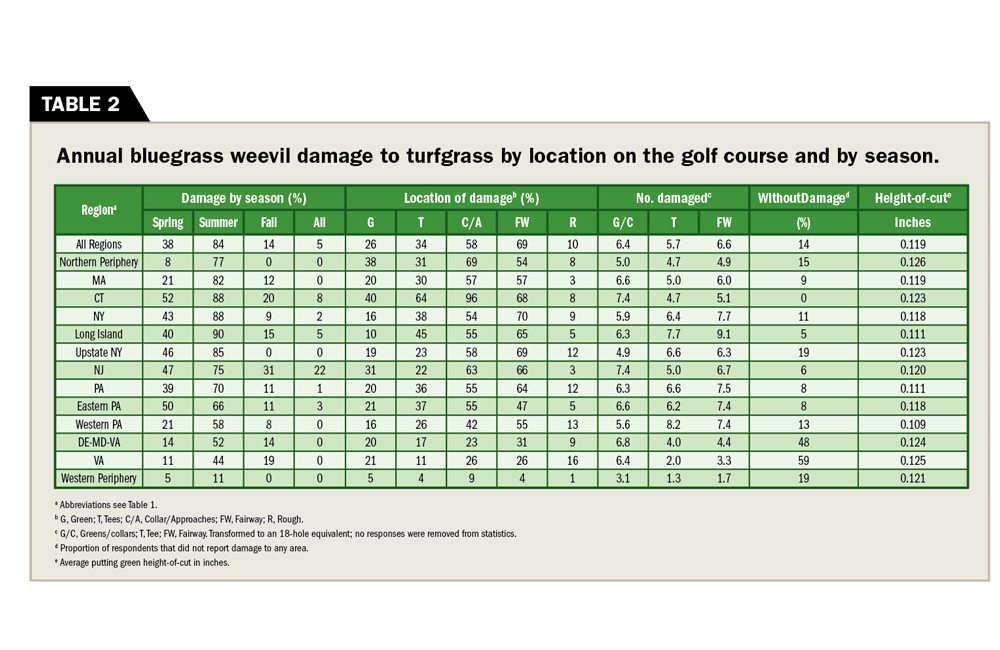 Damage by Turf Area
Damage by Turf Area
ABW damage was most common on fairways and collars/aprons (Table 2). Only 10 percent of respondents reported damage to roughs. This data is not surprising, given the weevil’s preference for annual bluegrass (Poa annua) and creeping bentgrass (Agrostis stolonifera) maintained under half-inch cutting heights (12,5) and the composition of turfgrasses likely to be found in rough (e.g., Poa pratensis, Festuca spp., Lolium perenne).
The incidence of damage to putting greens (26 percent) was unexpectedly high given the low mowing heights reported across the region and the traditionally high intensity of insecticide use on greens. Two-thirds of the courses that reported ABW damage to greens had heights of cut (HOC) greater than the survey average, which was 0.119 inches across all survey responses (Figure 2).
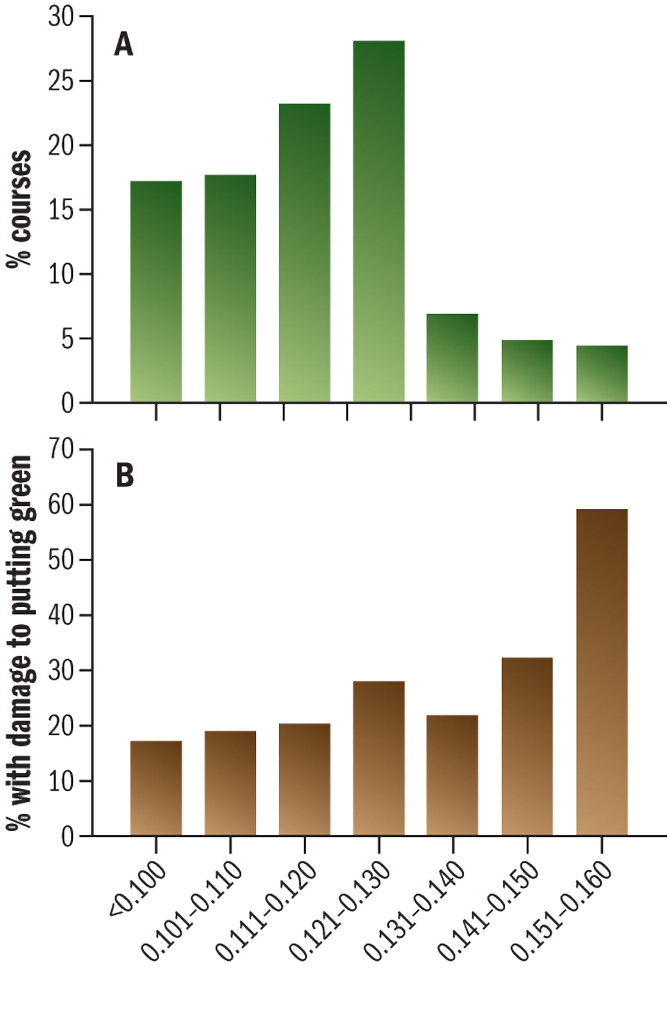
Figure 2
Regions with the highest incidence of damage to putting greens included Connecticut, northern peripheral states/ provinces and New Jersey (Table 2). The average putting green HOC of 0.120 to 0.126 inches in these regions was greater than the survey average. The lowest incidence of ABW damage to greens was reported in Long Island, and western Pennsylvania and the two subregions with the lowest average green HOC of 0.110 and 0.109 inches, respectively.
Seasonal damage
Most superintendents (84 percent) reported damage appearing in the summer, followed by 38 percent reporting springtime damage (Table 2). This result was surprising since larvae are more dense and aggregated in the first generation than in the following generations (13). Few reported fall damage (14 percent) or damage appearing during all three seasons (five percent).
New Jersey and eastern Pennsylvania had the highest spring damage (first generation larval). The regions further to the north, including Long Island, Connecticut, upstate New York and Massachusetts (90, 88, 85 and 82 percent,  respectively), reported a very high incidence of summer damage.
respectively), reported a very high incidence of summer damage.
New Jersey, Connecticut and Virginia reported the highest amounts of fall damage (31, 20 and 19 percent, respectively). The northern peripheral states/ provinces (Maine, New Hampshire, Vermont, Ontario, Quebec) reported the most damage in summer (77 percent), with no observations of damage occurring in all three seasons or solely in the fall.
Population Management
Budgets
The region’s annual maintenance budgets for all surveyed golf courses demonstrated peaks between $1.0 million and $1.5 million and between $350,000 and $550,000 per year (Table 3). Annual insecticide budgets averaged $9,270 and ranged between $50,00 and $75,000 per year. When adjusted for an 18-hole equivalent, the median insecticide budgets ranged between approximately $4,000 to $17,000, where there were enough responses to summarize (Table 4). We estimate that insecticides account for 1.23 percent of the total maintenance budget.
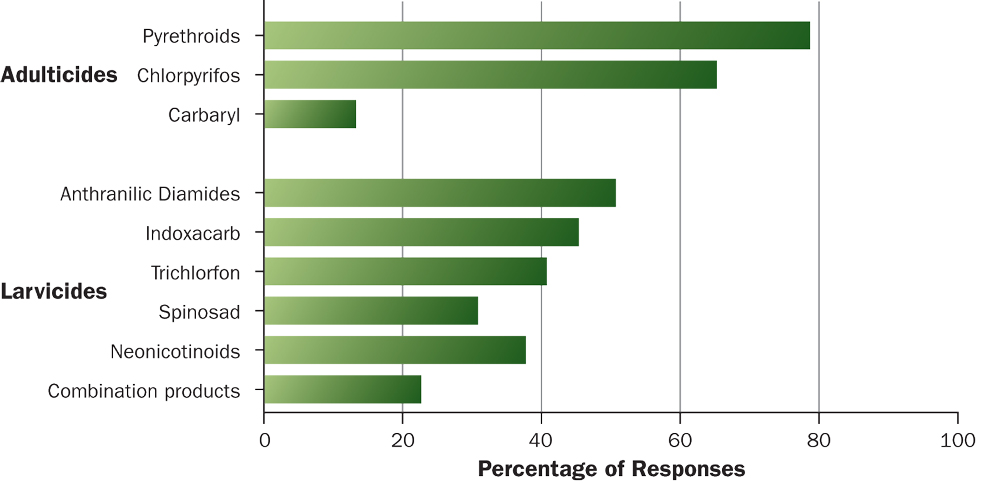
Figure 3
Chemical management
A significant portion of the survey’s questions dealt with insecticides, a primary component of most ABW management programs (7). Each superintendent surveyed identified at least one product used to manage the ABW, even though 10 percent of responders reported no damage to any areas (Figure 3).
The pyrethroids and chlorpyrifos (Dursban), used by 79 percent and 65 percent of respondents, respectively, were the most popular means of controlling ABW adults, despite the development of pyrethroid resistance (10,11) and indications that chlorpyrifos efficacy may also be reduced (1).
The anthranilic diamide, chlorantraniliprole (Acelepryn), was the most widely used larvicide, which may, in part, be due to its broad spectrum of activity and role in preventive white grub management. Cyantraniliprole (Ference), another anthranilic diamide, was not yet registered for turfgrass at the time of our survey.
Courses made an average of 3.9 insecticide applications per year to manage ABW (Table 4). Courses in states/regions with above-average application frequency were located around the epicenter of ABW distribution (New Jersey, Massachusetts, Connecticut, Pennsylvania and New York).
Superintendents on Long Island, where the relatively long- residual anthranilic diamides are not registered, made the most applications to control ABW per year (5.5) and had the highest use of pyrethroids (85 percent). Thirty percent of superintendents in this area reported making six or more annual ABW insecticide applications (survey average = 18 percent), and 20 percent made ten or more applications (survey average = six percent).
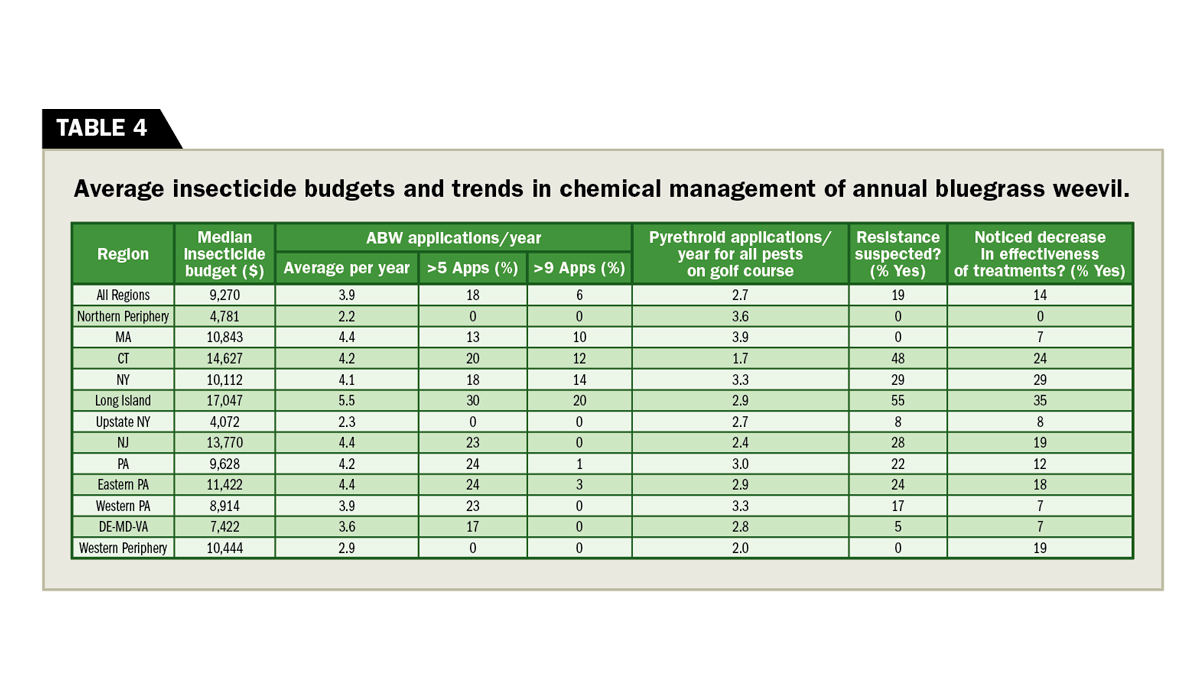
Pyrethroid-resistant populations
On average, superintendents reported making 2.7 pyrethroid applications per year (Table 4). The regions with the highest pyrethroid applications included MA and the northern peripheral states/provinces.
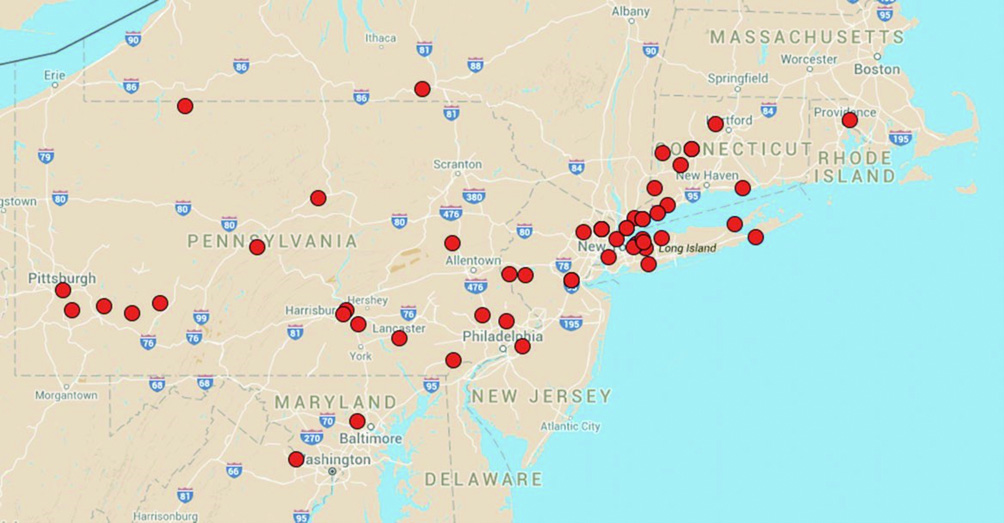 One in five courses reported having a pyrethroid-resistant ABW population either suspected or confirmed by bioassay. “Resistant” populations were located everywhere, though higher than average incidence came from areas with long histories of managing ABW, including Long Island, Connecticut and New Jersey (Table 4 and Figure 4).
One in five courses reported having a pyrethroid-resistant ABW population either suspected or confirmed by bioassay. “Resistant” populations were located everywhere, though higher than average incidence came from areas with long histories of managing ABW, including Long Island, Connecticut and New Jersey (Table 4 and Figure 4).
Overall, “resistant” ABW populations caused more damage than susceptible populations when grouped by seasonal damage incidence (93 percent vs. 74 percent of courses, respectively). Courses with “resistant” populations had a significantly greater number of turf areas damaged, including 84 percent and 85 percent of collars/approaches and fairways damaged, versus 48 percent and 52 percent for courses with susceptible populations.
Courses reporting resistance also had higher numbers of sites damaged (21.2 vs. 9.8 combined turf areas, respectively). Interestingly, a significantly higher percentage of “resistant” courses (36 percent) than susceptible courses (21 percent) reported damage to putting greens despite the “resistant” courses having a significantly lower average green HOC of 0.112 inches than the susceptible courses at 0.12 inches.
Chemical selection differed greatly between the two types of ABW populations (Figure 5). Larvicides, especially chlorantraniliprole, indoxacarb (Provaunt), spinosad (Conserve) and trichlorfon (Dylox), tended to be used more on courses with “resistant” than courses with susceptible populations.
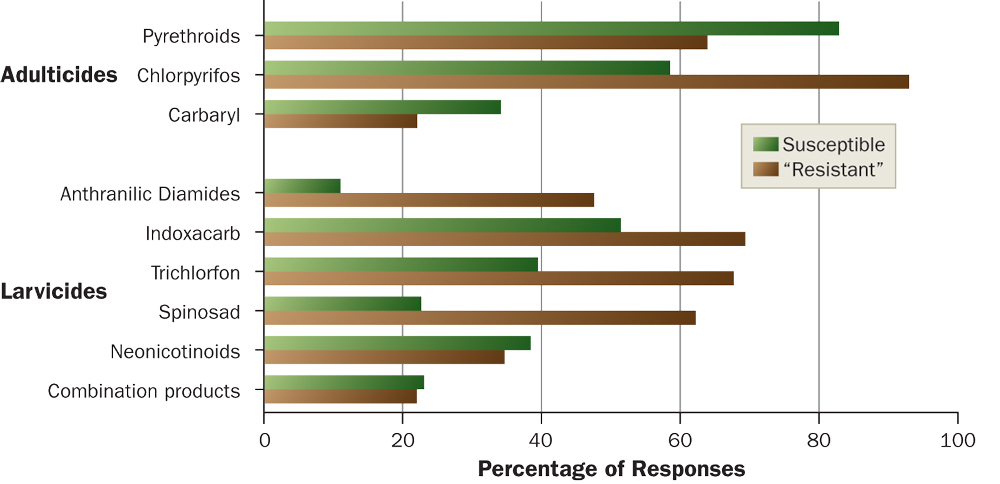
Figure 5
Most (93 percent) superintendents of courses with “resistant” populations used chlorpyrifos in adult management. A relatively high percentage of respondents (64 percent) still used pyrethroids. Also, “resistant” courses were much more likely than susceptible courses to select older broad-spectrum insecticides like trichlorfon (67 percent vs. 34 percent for susceptible courses).
Integrated Pest Management
Superintendents emphasize preventative control of pest problems to maintain aesthetics, playability and damage avoidance. Nevertheless, they can incorporate many aspects of integrated pest management (IPM) into their management of ABW, including monitoring, reducing chemically treated areas, using relatively resistant turfgrasses and applying curative controls (e.g., larvicides) to at-risk areas on the course. Most (73 percent) responders indicated that they “always” or “sometimes” employ spot treating as a means of controlling ABW. Only 16 percent indicated that they never spot treat.
 Monitoring Practices
Monitoring Practices
Superintendents regularly employ scouting techniques to estimate ABW population densities or determine their presence (Table 5). Most (90 percent) responders indicated they regularly use two or more monitoring techniques and 80 percent used three or more.
Only 5.1 percent indicated that they do not regularly monitor.
Conclusions
This survey provides a broad framework for understanding the importance and spread of ABW as a golf course pest, the spread and severity of insecticide resis- tance and the need to communicate best management practices for the pest. ABW clearly is a tremendous problem in the region, with 90 percent of respondents indicating damaging densities on their courses and about one-third of fairways, tees and greens/collars affected.
Resistance is already widespread, with 20 percent of responders (in some regions up to 55 percent) suspecting or having confirmed resistance. Since resistance may not be recognized until resistance ratios reach or pass about 30, many more courses will likely develop insecticide-resistant populations soon.
Despite reports of pyrethroid resistance, pyrethroids are still the most widely used insecticide class for ABW management, followed by another adulticide, chlorpyrifos. While “resistant” courses have made significant changes in insecticide use, notably greater adoption of larvicides and switching to chlorpyrifos as the primary adulticide, 64 percent of those courses still used pyrethroids.
Greater changes in types of insecticides used are likely being held back by a combination of risk-averseness, dominance of preventive approaches by superintendents and the much lower cost of adulticides compared to the more effective larvicides. However, few classes of insecticides are effective in controlling adult weevils, and the ability of those classes to control pyrethroid-resistant ABW populations is questionable, as highly pyrethroid-resistant populations already show increased tolerance if not resistance to all of them (4).
Our findings highlight the need for novel approaches to control adults. Registration of a new highly effective larvicide (cyantraniliprole, Ference) in 2015 (after this survey was conducted) is likely to increase larvicide use, at least against “resistant” populations.
Nearly all superintendents who deal with ABW monitor weevil populations, but the most widely used methods only help with the insecticide application timing instead of estimating population densities. However, 56 percent of respondents used soil cores to scout for larval stages, which is the most direct and likely most precise method to assess the need for treatments. Larvae monitoring will become critical if more courses move away from primary reliance on adulticides.
Because highly resistant ABW populations are also more tolerant if not resistant to most of the currently available larvicides (4), superintendents will also have to start relying more on biorational insecticides and cultural means to manage weevil populations. We are evaluating alternatives based on azadirachtin, Bacillus thuringiensis and entomopathogenic nematodes and some of them may offer viable options. Such options may become increasingly used, at least on courses with resistant ABW populations or ones in localities (e.g., Long Island, N.Y.) with special insecticide use restrictions.










